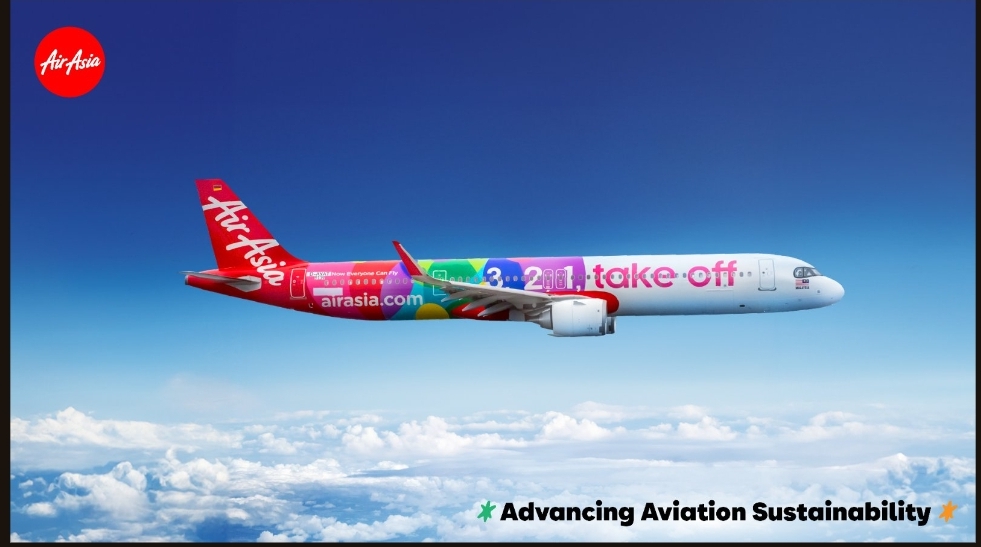AirAsia and Airbus announce wide-ranging partnership to accelerate aviation sustainability
AirAsia today announced a new chapter in its long-term partnership with European aircraft manufacturer Airbus to advance research into aviation sustainability initiatives that lower carbon emissions in the ASEAN region.
In a Memorandum of Understanding between their sustainability divisions, AirAsia and Airbus established a collaboration to explore decentralized production of Sustainable Aviation Fuel (SAF) using alternative feedstock and technologies in Southeast Asia. The research-based partnership aims to identify opportunities to support the onward commercial development of promising projects to expand SAF supply in the region.
The MoU also set forth conditions to jointly investigate advanced measures to improve air traffic management (ATM) to reduce CO2 emissions, leveraging AirAsia’s industry-leading fuel efficiency programme and Airbus’ pioneering role as a global leader in aeronautics, space and related services. The organizations will be identifying applicable solutions developed as part of the Single European Sky ATM Research (SESAR) Project* and assessing their suitability for adaptation to ASEAN skies.

Capital A Chief Sustainability Officer, Yap Mun Ching said, “AirAsia will be a key partner of Airbus in ASEAN to test the feasibility of SAF output developed using alternative feedstock and technologies, as well as ground-breaking ATM initiatives supported by Airbus’ innovation teams. As a regional carrier based in five ASEAN countries, we bring unparalleled operational experience in the region to complement Airbus’ technological expertise. The partnership establishes a foundation upon which to build joint projects at multiple levels that address the broad needs of improving the environmental performance of the sector.”
Yap said the partnership directly addresses the prerogative for the aviation sector to invest in and scale up in-sector solutions that are critical to decarbonising the industry. Other than improvements in efficiency and adoption of SAF, she said a key pathway for AirAsia to achieve net zero by 2050 is by upgrading the airline’s fleet to the most fuel-efficient models.
In June, AirAsia took delivery of its first brand new A321neo aircraft since the Covid-19 pandemic. The airline will receive five more aircraft in the fourth quarter of the year for entry into service in Malaysia and Thailand. All Airbus aircraft deliveries to AirAsia starting 2024 will be fulfilled using a fuel blend inclusive of 5% SAF.
Airbus Chief Sustainability Officer, Julie Kitcher said, “Airbus is contributing to the decarbonisation of aviation around the world. That means working with our customers in every region, looking at all solutions available today and collaborating on research for future technologies. AirAsia is a key partner in the ASEAN region and we are excited to work with the airline to explore operational efficiency levers, including air traffic management and scaling up the production and distribution of SAF.”
AirAsia currently holds an order for 361 units of the A321 model to meet the airline group’s fleet growth and replacement needs. By 2035, aircraft upgrades are expected to account for up to 10% reduction in AirAsia’s CO2 emissions compared to its 2019 baseline. Operational efficiencies and SAF are expected to deliver another 15% in reduction as the airline group charts its pathway towards net zero by 2050.
In 2023, AirAsia avoided emitting 130,000 tonnes of CO2 from its narrowbody regional network through the implementation of over 20 operational efficiency measures, equivalent to the impact of more than 2 million trees planted**. These measures contributed to a reduction in fuel costs amounting to US$40 million and over US$388,000 in shadow carbon costs.
*SESAR is the technological pillar of the EU’s Single European Skies initiative aimed at modernizing Europe’s air and ground ATM infrastructure and procedures to enhance safety, cost-efficiency and environmental performance. Launched in 2004, more than €2 billion has been committed to the development phase of SESAR’s ambitious goals.
**United States Environmental Protection Agency, ‘Greenhouse Gases Equivalencies Calculator - Calculations and References: Number of urban tree seedlings grown for 10 years'.

Comments
Post a Comment